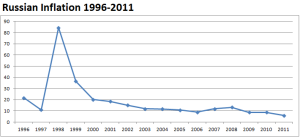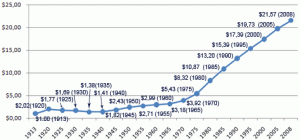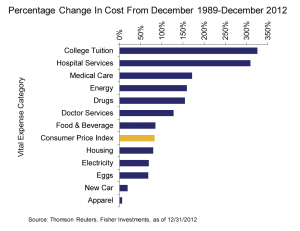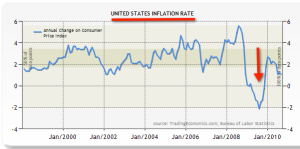While we encounter inflation everyday in our lives, and most of us don’t think too much about it. But here are 6 surprising facts about inflation that might make you rethink how inflation might impact you. Click here for a similar list about GDP.
- Inflation in the US
While here in the US, we do not really have an inflation problem, and many simply ignore inflation altogether. On average (from 1913 to 2006), the rate of inflation in the US is 3.45 percent per year, at this rate, price level doubles every 21 years. This is equivalent to saying that a dollar today is worth only 50 cents 21 years from now. Keep this in mind the next time you decide to invest in a bond or want to plan for your retirements – inflation really do eats away at those returns!
- Frequencies of hyperinflation
Hyperinflation happens more often than you think. From 1900 to 2013, there have been 56 recorded cases of hyperinflation (essentially runaway inflation that made that results from a combination of bad fiscal policy and a lack of public confidence in the value of the currency). It happened not only during 1920s Germany or Zimbabwe in the 2000s, but also places like Argentina and Brazil in 1989, Russia in 1992, and the former Yugoslavia in 1994.

- When hyperinflation occurs
Historically, hyperinflation generally occurs during periods of political transitions or after a national catastrophe, usually war. Examples: in the former Soviet republics from 1992 to 1993 (in Armenia, it reached monthly inflation rates of 438 percent, in the Ukraine it reached 285%); in China immediately after the collapse of the Nationalist government in 1948 and shortly before the Communist victory; and during the devastation in the 1990s of the Yugoslav wars, etc.
- Inflation does not necessarily increase the cost of living
Inflation is defined as the average increase in price levels over a given period of time. However, not all of us purchase the same type of goods and services. Therefore, inflation for each person is different. For someone who spends a large chunk of their income on transportation might experience very modest increases in cost of living even if other products on the market increased in prices dramatically.
- Inflation in certain sectors of the economy dramatically out-paced that of others
Inflation can vary dramatically, depending on which sector of the economy we look at. Certain products and services like college tuition and hospital services increased in prices by 300% from 1989 to 2012; Compare this with the increase in the price of a new car, which increased by about 20-30% over the course of the same period. Clearly, while no doubt inflation affects all sectors of the economy, some sectors are clearly more impacted. (Personally, as a college student, the high increases in college tuition is indeed a source of constant worry).
- Inflation is not necessarily bad
In fact, a modest amount of inflation is normal in a healthy and growing economy. Price volatility is a normal part of the economic picture and no central bank had ever set the interest rate at 0%. What is truly bad for the economy is the prospects of deflation, a general fall in prices over a certain period of time. In this scenario, businesses would invest less (resulting in lowered economic output), layoffs and mass unemployment will follow. Unsurprisingly, deflation often occurs hand in hand with recession and can in fact worsen an economic contraction. In 2009, the United States had its first case of deflation since the Depression years of the 1930s.





2 thoughts on “6 Surprising Facts about Inflation”